Package Integration and System Performance Analysis of Glass-Based Passive Components for 5G New Radio Millimeter-Wave Modules
Abstract
1. Introduction
2. Design of Integrated Passive Components
2.1. Material Stackup
2.2. Filter, Diplexer and Coupler Design
3. Fabrication Process
4. Results and Discussion
4.1. Characterization Results of Diplexers
4.1.1. Hairpin Diplexers
4.1.2. Interdigital Diplexer
4.1.3. Edge–Coupled Diplexer
4.2. Characterization Results of Coupler and Integrated Passive Component Block
4.3. Dimensional Analysis
5. System Performance Analysis
- Group delay variation at antenna port and power variation at detector port of system as RF source power is varied.
- EVM of integrated passive component block using RF carrier modulated by /4 DQPSK and 64–QAM.
5.1. System–Level Simulation # 1
5.2. System–Level Simulation # 2
5.3. Relationship Between Component Parameters and EVM
- Sweep a 64–QAM–modulated RF carrier with 1.5, 2 and 3 GHz symbol rates over the passband of two filters (A and B) for band n257 (Figure 20).
- The filters have different bandwidths, roll offs and ripple characteristics.
- As the symbol rate increases, the EVM rapidly degrades, especially near the band edge.
- Filter A shows low EVM variation (EVM < 2.3% at 1.5 GHz) with a minimum EVM of 5.6%.
- Filter B has a minimum EVM of 5.2% and EVM < 1.9%, indicating the impact of a lower ripple compared to Filter A.
- The rejection roll–off of filters influences the asymmetric EVM response.
6. Conclusions
Author Contributions
Funding
Data Availability Statement
Acknowledgments
Conflicts of Interest
References
- Rappaport, T.S.; Sun, S.; Mayzus, R.; Zhao, H.; Azar, Y.; Wang, K.; Wong, G.N.; Schulz, J.K.; Samimi, M.; Gutierrez, F. Millimeter Wave Mobile Communications for 5G Cellular: It Will Work! IEEE Access 2013, 1, 335–349. [Google Scholar] [CrossRef]
- Boccardi, F.; Heath, R.W.; Lozano, A.; Marzetta, T.L.; Popovski, P. Five disruptive technology directions for 5G. IEEE Commun. Mag. 2014, 52, 74–80. [Google Scholar] [CrossRef]
- Ilderem, V. The technology underpinning 5G. Nat. Electron. 2020, 3, 5–6. [Google Scholar] [CrossRef]
- Gupta, A.; Jha, R.K. A Survey of 5G Network: Architecture and Emerging Technologies. IEEE Access 2015, 3, 1206–1232. [Google Scholar] [CrossRef]
- Chapter 12: 5G Communications. In Heterogeneous Integration Roadmap; IEEE: Piscataway, NJ, USA, 2019; Available online: https://eps.ieee.org/technology/heterogeneous-integration-roadmap/2021-edition.html (accessed on 13 April 2025).
- Huo, Y.; Dong, X.; Xu, W. 5G Cellular User Equipment: From Theory to Practical Hardware Design. IEEE Access 2017, 5, 13992–14010. [Google Scholar] [CrossRef]
- Thai, T.; Dalmia, S.; Hagn, J.; Talebbeydokhti, P.; Tsfati, Y. Novel Multicore PCB and Substrate Solutions for Ultra Broadband Dual Polarized Antennas for 5G Millimeter Wave Covering 28GHz and 39GHz Range. In Proceedings of the 2019 IEEE 69th Electronic Components and Technology Conference (ECTC), Las Vegas, NV, USA, 28–31 May 2019; pp. 954–959. [Google Scholar]
- Talebbeydokhti, P.; Dalmia, S.; Thai, T.; Sover, R.; Tal, S. Ultra Large Area SIPs and Integrated mmW Antenna Array Module for 5G mmWave Outdoor Applications. In Proceedings of the 2019 IEEE 69th Electronic Components and Technology Conference (ECTC), Las Vegas, NV, USA, 28–31 May 2019; pp. 294–299. [Google Scholar]
- Aryanfar, F.; Pi, J.; Zhou, H.; Henige, T.; Xu, G.; Abu-Surra, S.; Psychoudakis, D.; Khan, F. Millimeter-wave base station for mobile broadband communication. In Proceedings of the 2015 IEEE MTT-S International Microwave Symposium, Phoenix, AZ, USA, 17–22 May 2015; pp. 1–3. [Google Scholar] [CrossRef]
- Gu, X.; Liu, D.; Baks, C.; Tageman, O.; Sadhu, B.; Hallin, J.; Rexberg, L.; Valdes-Garcia, A. A multilayer organic package with 64 dual-polarized antennas for 28GHz 5G communication. In Proceedings of the 2017 IEEE MTT-S International Microwave Symposium (IMS), Honolulu, HI, USA, 4–9 June 2017; IEEE: Piscataway, NJ, USA, 2017; pp. 1899–1901. [Google Scholar]
- Valdes-Garcia, A.; Sadhu, B.; Gu, X.; Tousi, Y.; Liu, D.; Reynolds, S.K.; Haillin, J.; Sahl, S.; Rexberg, L. Circuit and antenna-in-package innovations for scaled mmWave 5G phased array modules. In Proceedings of the 2018 IEEE Custom Integrated Circuits Conference (CICC), San Diego, CA, USA, 8–11 April 2018; IEEE: Piscataway, NJ, USA, 2018; pp. 1–8. [Google Scholar]
- Chang, Y.; Chen, J.; Chung, W.; Li, W.; Shih, P.B.; Ng’oma, A.; Yang, C.; Huang, M.; Lin, H.; Wang, C.; et al. A novel fabrication process and measurement results of a 28GHz glass antenna with single TGV for 5G communication applications. In Proceedings of the 2019 14th International Microsystems, Packaging, Assembly and Circuits Technology Conference (IMPACT), Taipei, Taiwan, 23–25 October 2019; pp. 112–115. [Google Scholar] [CrossRef]
- Bowrothu, R.; Yoon, Y.; Zhang, J. Through Glass Via (TGV) Based Band Pass Filter for 5G Communications. In Proceedings of the 2018 IEEE 68th Electronic Components and Technology Conference (ECTC), San Diego, CA, USA, 29 May–1 June 2018; pp. 1097–1102. [Google Scholar]
- Letz, M. Glasses and Glass Ceramics for Applications in High Frequency Electronics. In Proceedings of the 2019 IEEE MTT-S International Microwave Workshop Series on Advanced Materials and Processes for RF and THz Applications (IMWS-AMP), Bochum, Germany, 16–18 July 2019; pp. 85–87. [Google Scholar] [CrossRef]
- Hayashi, K.; Sawamura, S.; Nomura, S.; Suzuki, N.; Takekoshi, M. Development and Evaluation of Carrier Glass Substrate for Fan-Out WLP/PLP Process. In Proceedings of the 2017 IEEE 67th Electronic Components and Technology Conference (ECTC), Orlando, FL, USA, 30 May–2 June 2017; pp. 896–901. [Google Scholar] [CrossRef]
- 3GPP. 5G; NR; Base Station (BS) Radio Transmission and Reception; Technical Specification (TS) 38.104 Release 15 Version 15.5.0, 3rd Generation Partnership Project (3GPP); European Telecommunications Standards Institute (ETSI): Sophia Antipolis, France, 2019. [Google Scholar]
- 3GPP. 5G; NR; Base Station (BS) Radio Transmission and Reception; Technical Specification (TS) 38.104 Release 16 Version 16.3.0, 3rd Generation Partnership Project (3GPP); European Telecommunications Standards Institute (ETSI): Sophia Antipolis, France, 2020. [Google Scholar]
- Glynn, S.; Pearson, G.; Devlin, L. An SMT packaged dual-channel PA for the 26 GHz 5G pioneer band. In Proceedings of the ARMMS RF & Microeave Conference, Penang, Malaysia, 17–19 December 2018; pp. 12–16. [Google Scholar]
- Mu, X.; Sun, W. Minimizing radiated power variation in power amplifier FEMs with directional couplers. In Proceedings of the 2010 International Symposium on Signals, Systems and Electronics, Nanjing, China, 17–20 September 2010; Volume 2, pp. 1–3. [Google Scholar] [CrossRef]
- Madic, J.; Bretchko, P.; Zhang, S.; Shumovich, R.; McMorrow, R. Accurate power control technique for handset PA modules with integrated directional couplers. In Proceedings of the IEEE Radio Frequency Integrated Circuits (RFIC) Symposium; Shumovich, Philadelphia, PA, USA, 8–13 June 2003; pp. 715–718. [Google Scholar]
- Ali, M.; Liu, F.; Watanabe, A.; Raj, P.M.; Sundaram, V.; Tentzeris, M.M.; Tummala, R.R. Miniaturized High-Performance Filters for 5G Small-Cell Applications. In Proceedings of the 2018 IEEE 68th Electronic Components and Technology Conference (ECTC), San Diego, CA, USA, 29 May–1 June 2018; pp. 1068–1075. [Google Scholar] [CrossRef]
- Ali, M.; Liu, F.; Watanabe, A.; Raj, P.M.; Sundaram, V.; Tentzeris, M.M.; Tummala, R.R. First Demonstration of Compact, Ultra-Thin Low-Pass and Bandpass Filters for 5G Small-Cell Applications. IEEE Microw. Wirel. Components Lett. 2018, 28, 1110–1112. [Google Scholar] [CrossRef]
- Ali, M.; Abbas, T. Compact, meandered-line microstrip bandpass filter. In Proceedings of the 17th IEEE International Multi Topic Conference 2014, Karachi, Pakistan, 8–10 December 2014; pp. 67–72. [Google Scholar] [CrossRef]
- Ali, M.; Watanabe, A.; Lin, T.H.; Pulugurtha, M.R.; Tentzeris, M.M.; Tummala, R.R. 3D Glass Package-Integrated, High-Performance Power Dividing Networks for 5G Broadband Antennas. In Proceedings of the 2019 IEEE 69th Electronic Components and Technology Conference (ECTC), Las Vegas, NV, USA, 28–31 May 2019; pp. 960–967. [Google Scholar]
- Ali, M.; Watanabe, A.; Lin, T.; Tentzeris, M.; Tummala, R.; Raj, P.M. Ultra-Wideband, Glass Package-Integrated Power Dividers for 5G and mm-Wave Applications. In Proceedings of the 2019 IEEE International Symposium on Antennas and Propagation and USNC-URSI Radio Science Meeting, Atlanta, GA, USA, 7–12 July 2019; IEEE: Piscataway, NJ, USA, 2019; pp. 863–864. [Google Scholar]
- Watanabe, A.O.; Ali, M.; Tehrani, B.; Hester, J.; Matsuura, H.; Ogawa, T.; Raj, P.M.; Sundaram, V.; Tentzeris, M.M.; Tummala, R.R. First demonstration of 28 ghz and 39 ghz transmission lines and antennas on glass substrates for 5g modules. In Proceedings of the 2017 IEEE 67th Electronic Components and Technology Conference (ECTC), Orlando, FL, USA, 30 May–2 June 2017; IEEE: Piscataway, NJ, USA, 2017; pp. 236–241. [Google Scholar]
- Ali, M. Advanced 5G Substrates with Integrated Antennas. Ph.D. Thesis, Georgia Institute of Technology, Atlanta, GA, USA, 2017. [Google Scholar]
- Hong, J.S.G.; Lancaster, M.J. Microstrip Filters for RF/Microwave Applications; John Wiley & Sons: Hoboken, NJ, USA, 2004; Volume 167. [Google Scholar]
- Matthaei, G.; Young, L.; Jones, E. Microwave Filters, Impedance-matching Networks, and Coupling Structures; Artech House Microwave Library, Artech House Books: London, UK, 1980. [Google Scholar]
- Mu, X.; Alon, Z.; Zhang, G.; Chang, S. Analysis of output power variation under mismatched load in Power Amplifier FEM with directional coupler. In Proceedings of the 2009 IEEE MTT-S International Microwave Symposium Digest, Boston, MA, USA, 7–12 June 2009; pp. 549–552. [Google Scholar] [CrossRef]
- Raj, P.M.; Nair, C.; Lu, H.; Liu, F.; Sundaram, V.; Hess, D.W.; Tummala, R. “Zero-undercut” Semi-additive Copper Patterning—A Breakthrough for Ultrafine-line RDL Lithographic Structures and Precision RF Thinfilm Passives. In Proceedings of the 2015 IEEE 65th Electronic Components and Technology Conference (ECTC), San Diego, CA, USA, 26–29 May 2015; pp. 402–405. [Google Scholar] [CrossRef]
- Lu, H.; Furuya, R.; Sawyer, B.M.D.; Nair, C.; Liu, F.; Sundaram, V.; Tummala, R.R. Design, Modeling, Fabrication and Characterization of 2–5-μm Redistribution Layer Traces by Advanced Semiadditive Processes on Low-Cost Panel-Based Glass Interposers. IEEE Trans. Components, Packag. Manuf. Technol. 2016, 6, 959–967. [Google Scholar] [CrossRef]
- NovaBond–IT. Advanced Non-Etching Adhesion Promoter for IC-Substrate and High Frequency Applications. Available online: https://www.atotech.com/products/electronics/surface-treatment/novabond-it/ (accessed on 13 April 2025).
- High Frequency 50 GHz Thin Film Chip Resistor—Data Sheet. Available online: https://www.vishay.com/docs/53081/chdesignkit.pdf (accessed on 13 April 2025).
- Showail, J.; Lahti, M.; Kari, K.; Arabi, E.; Rantakari, P.; Huhtinen, I.; Vaha-Heikkila, T.; Shamim, A. SIW Cavity Filters with Embedded Planar Resonators in LTCC Package for 5G Applications. In Proceedings of the 2018 48th European Microwave Conference (EuMC), Madrid, Spain, 23–27 September 2018; pp. 757–760. [Google Scholar]
- Showail, J. System on Package (SoP) Millimeter Wave Filters for 5G Applications. Ph.D. Thesis, KAUST, Thuwal, Saudi Arabia, 2018. [Google Scholar] [CrossRef]
- Ahn, K.; Yom, I. A Ka-band multilayer LTCC 4-pole bandpass filter using dual-mode cavity resonators. In Proceedings of the 2008 IEEE MTT-S International Microwave Symposium Digest, Atlanta, GA, USA, 15–20 June 2008; pp. 1235–1238. [Google Scholar]
- Chin, K.; Chang, C.; Chen, C.; Guo, Z.; Wang, D.; Che, W. LTCC Multilayered Substrate-Integrated Waveguide Filter With Enhanced Frequency Selectivity for System-in-Package Applications. IEEE Trans. Components, Packag. Manuf. Technol. 2014, 4, 664–672. [Google Scholar] [CrossRef]
- Chen, X.; Wu, K. Self-Packaged Millimeter-Wave Substrate Integrated Waveguide Filter With Asymmetric Frequency Response. IEEE Trans. Components, Packag. Manuf. Technol. 2012, 2, 775–782. [Google Scholar] [CrossRef]
- Zhai, G.; Shi, B. Substrate integrated waveguide bandpass filter with enhancement of out-band suppression using C-shaped symmetrical slots. In Proceedings of the 2017 IEEE 2nd International Conference on Signal and Image Processing (ICSIP), Singapore, 4–6 August 2017; pp. 427–431. [Google Scholar]
- Yan, Y.; Chang, Y.; Wang, H.; Wu, R.; Chen, C.H. Highly Selective Microstrip Bandpass Filters in Ka-Band. In Proceedings of the 2002 32nd European Microwave Conference, Milan, Italy, 23–26 September 2002; pp. 1–4. [Google Scholar]
- Martin, T.; Ghiotto, A.; Vuong, T.; Lotz, F.; Monteil, P. High performance air-filled substrate integrated waveguide filter post-process tuning using capacitive post. In Proceedings of the 2017 IEEE MTT-S International Microwave Symposium (IMS), Honololu, HI, USA, 4–9 June 2017; pp. 196–199. [Google Scholar]
- Shaman, H.; Almorqi, S.; Haraz, O.; Alshebeili, S.; Sebak, A. Millimeter-wave microstrip diplexer using elliptical open-loop ring resonators for next generation 5G wireless applications. In Proceedings of the 2014 Mediterranean Microwave Symposium (MMS2014), Marrakech, Morocco, 12–14 December 2014; pp. 1–4. [Google Scholar] [CrossRef]
- Hong, S.; Chang, K. Stub-tuned microstrip bandpass filters for millimeter-wave diplexer design. IEEE Microw. Wirel. Components Lett. 2005, 15, 582–584. [Google Scholar] [CrossRef]
- Tang, H.J.; Hong, W.; Chen, J.; Luo, G.Q.; Wu, K. Development of Millimeter-Wave Planar Diplexers Based on Complementary Characters of Dual-Mode Substrate Integrated Waveguide Filters With Circular and Elliptic Cavities. IEEE Trans. Microw. Theory Tech. 2007, 55, 776–782. [Google Scholar] [CrossRef]
- Tuovinen, T.; Tervo, N.; Pärssinen, A. RF system requirement analysis and simulation methods towards 5G radios using massive MIMO. In Proceedings of the 2016 46th European Microwave Conference (EuMC), London, UK, 4–6 October 2016; pp. 142–145. [Google Scholar]
- >1.5 W (34 dBm) 24 to 34 GHz, GaAs, pHEMT, MMIC Power Amplifier (HMC943APM5E). Datasheet, Analog Devices. Available online: https://www.analog.com/media/en/technical-documentation/data-sheets/hmc943apm5e.pdf (accessed on 13 April 2025).
- TDK. Multilayer Band Pass Filter For 27.5-29.5GHz MMCB2528G5T-0001A3; Datasheet; TDK Corporation: Tokyo, Japan, 2019; Available online: https://product.tdk.com/en/system/files/dam/doc/product/rf/rf/filter/catalog/rf_bpf_mmcb2528g5t-0001a3_en.pdf (accessed on 13 April 2025).
- Knowles Precision Devices. 28 GHz Surface Mount Bandpass Filter—B280MD1S; Datasheet; Knowles Precision Devices: Cazenovia, NY, USA, 2020; Available online: https://www.digikey.com/en/products/detail/knowles-dielectric-labs/B280MD1S-T/25899358?msockid=0e1bd559cc0a6e361773c097cda96fec (accessed on 13 April 2025).
- Knowles Precision Devices. 28 GHz Surface Mount Bandpass Filter—B280MB1S; Datasheet; Knowles Precision Devices: Cazenovia, NY, USA, 2020. [Google Scholar]
- Shafik, R.A.; Rahman, M.S.; Islam, A.R. On the Extended Relationships Among EVM, BER and SNR as Performance Metrics. In Proceedings of the 2006 International Conference on Electrical and Computer Engineering, Dhaka, Bangladesh, 19–21 December 2006; pp. 408–411. [Google Scholar]
- Shafik, R.A.; Rahman, M.S.; Islam, A.R.; Ashraf, N.S. On the error vector magnitude as a performance metric and comparative analysis. In Proceedings of the 2006 International Conference on Emerging Technologies, Dhaka, Bangladesh, 19-21 December 2006; pp. 27–31. [Google Scholar]
- Kursu, O.; Leinonen, M.E.; Destino, G.; Tervo, N.; Sonkki, M.; Rahkonen, T.; Pärssinen, A.; Tammelin, S.; Pettissalo, M.; Korvala, A. Design and measurement of a 5G mmW mobile backhaul transceiver at 28 GHz. EURASIP J. Wirel. Commun. Netw. 2018, 2018, 201. [Google Scholar] [CrossRef]
- Sahyoun, W.; Benech, P.; Duchamp, J. Pseudo-time domain filter characterization using EVM parameter. In Proceedings of the The 40th European Microwave Conference, Paris, France, 28–30 September 2010; pp. 1281–1284. [Google Scholar]
- 3GPP. 5G; NR; User Equipment (UE) Conformance Specification; Radio Transmission and Reception Part 1: Range 1 Standalone; Technical Specification (TS) 38.521-1 Release 16 Version 16.3.0; 3rd Generation Partnership Project (3GPP); European Telecommunications Standards Institute (ETSI): Sophia Antipolis, France, 2020. [Google Scholar]
- Sahyoun, W.; Duchamp, J.; Benech, P. Validation of EVM Method for Filter Test Using Butterworth and Chebyshev Filters. IEEE Trans. Microw. Theory Tech. 2016, 64, 952–960. [Google Scholar] [CrossRef]
- Dilek, S.M.; Henneberger, R.; Kallfass, I. Performance Analysis of E-Band Duplex Transceiver Based on Waveguide Diplexer Filters. In Proceedings of the 2018 48th European Microwave Conference (EuMC), Madrid, Spain, 23–27 September 2018; pp. 1069–1072. [Google Scholar]
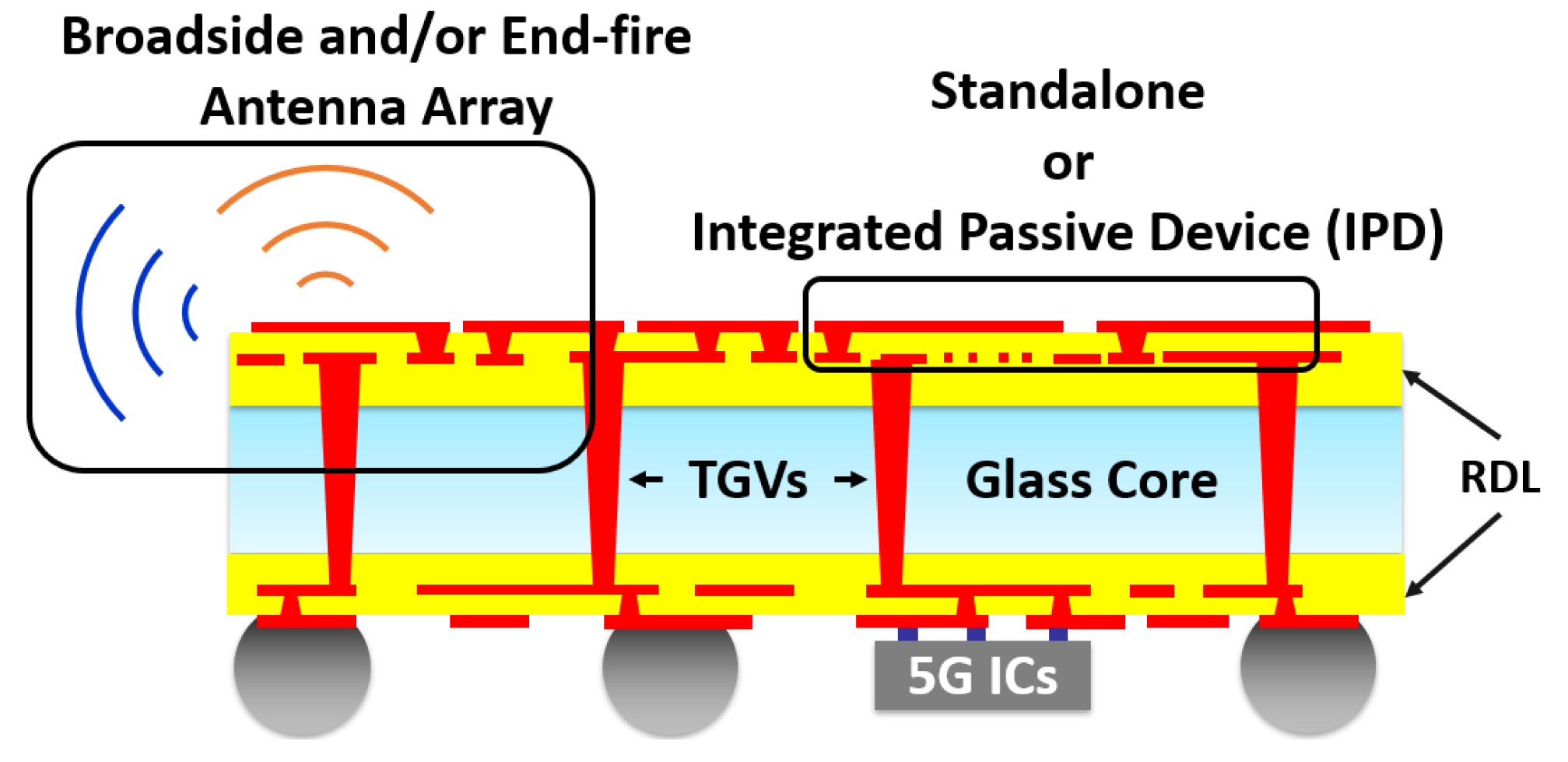
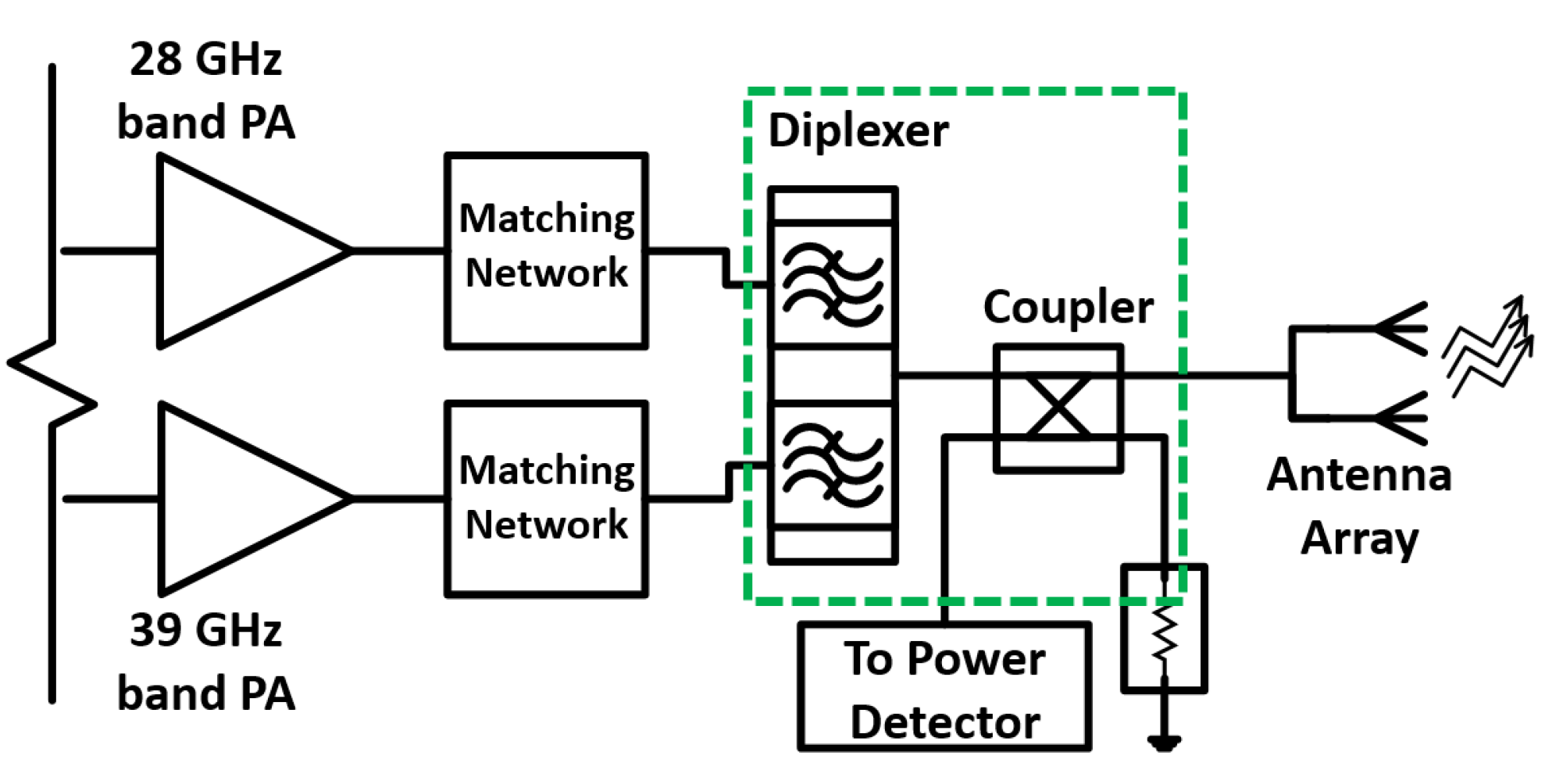
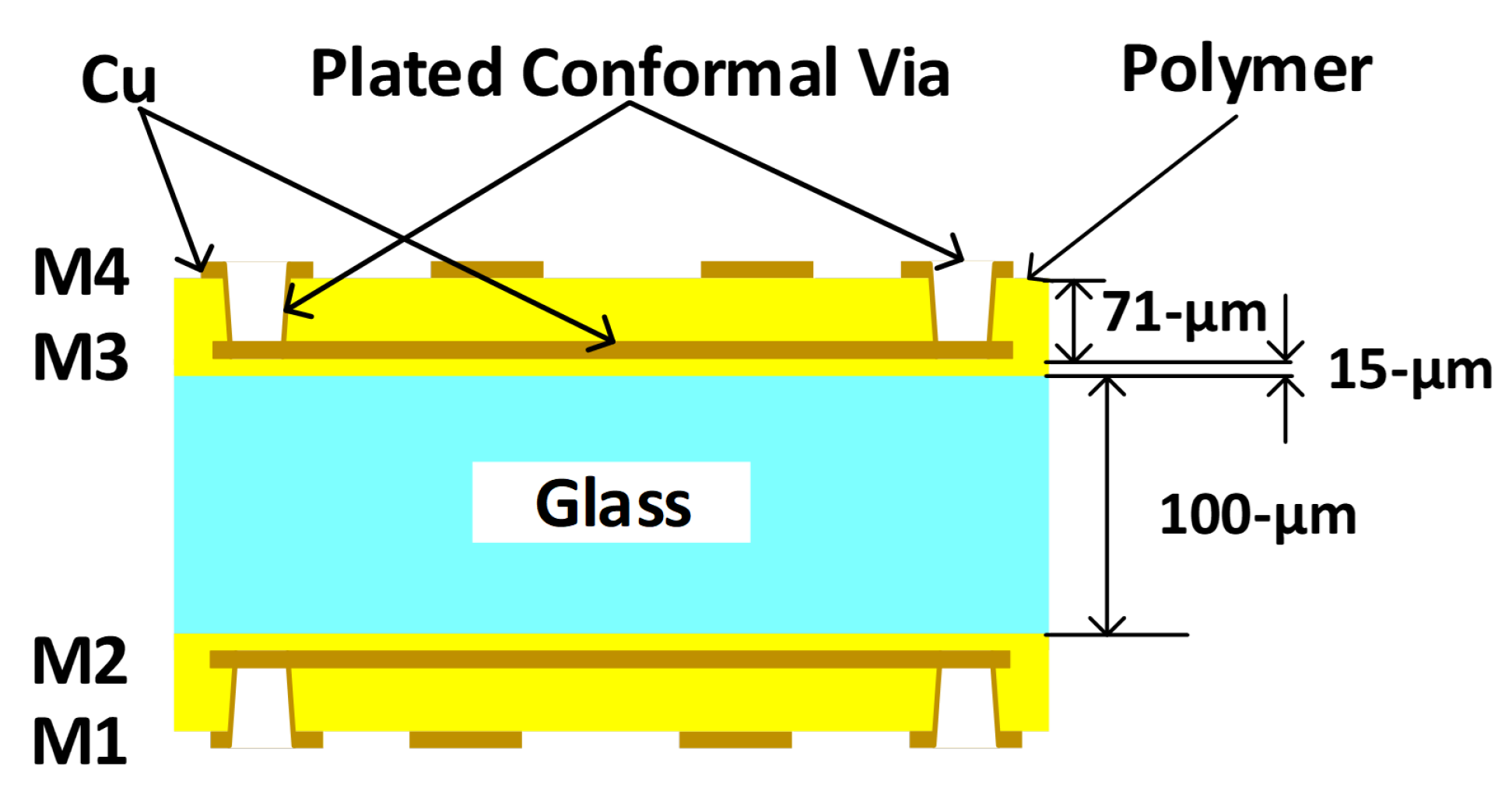
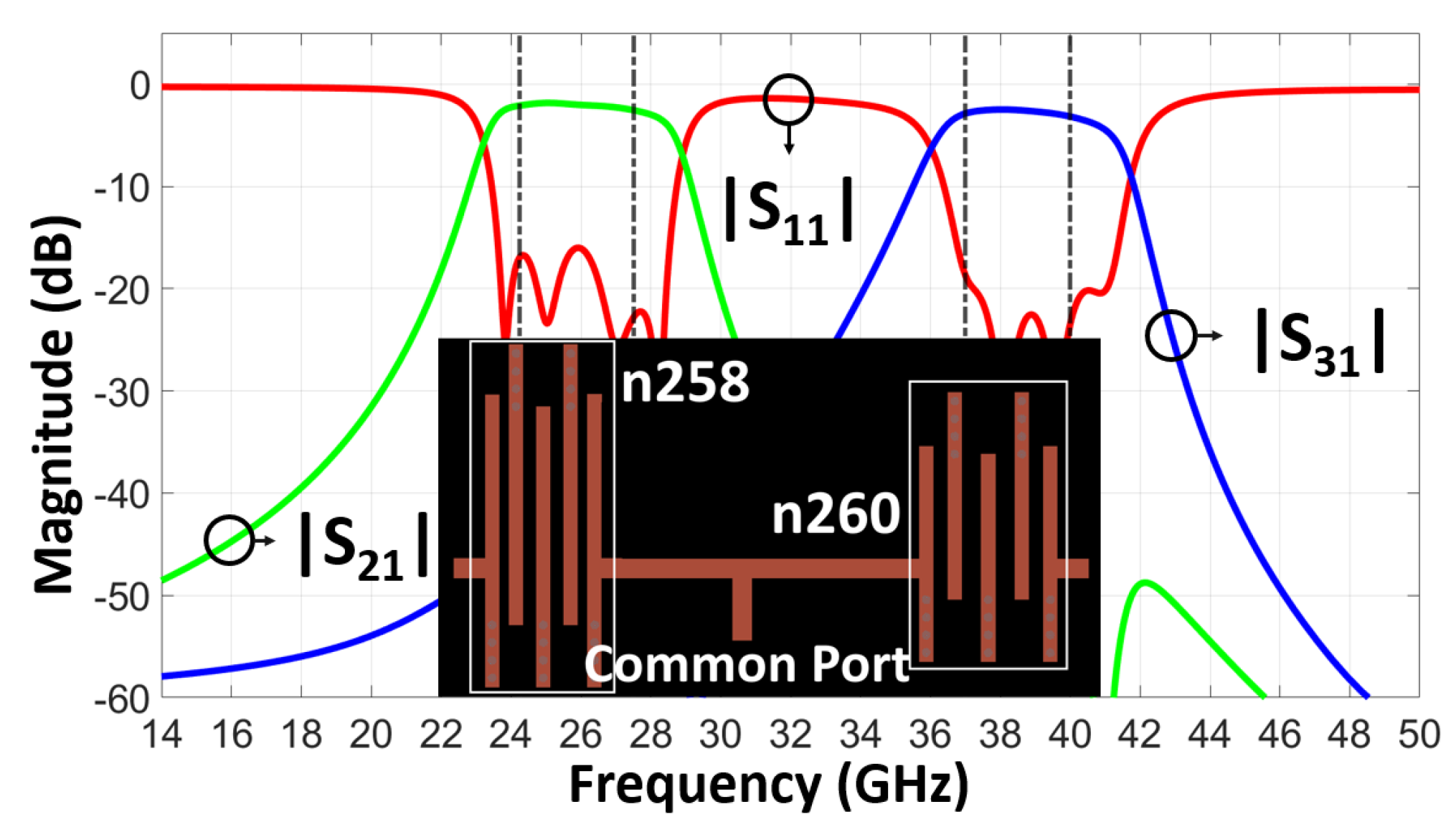

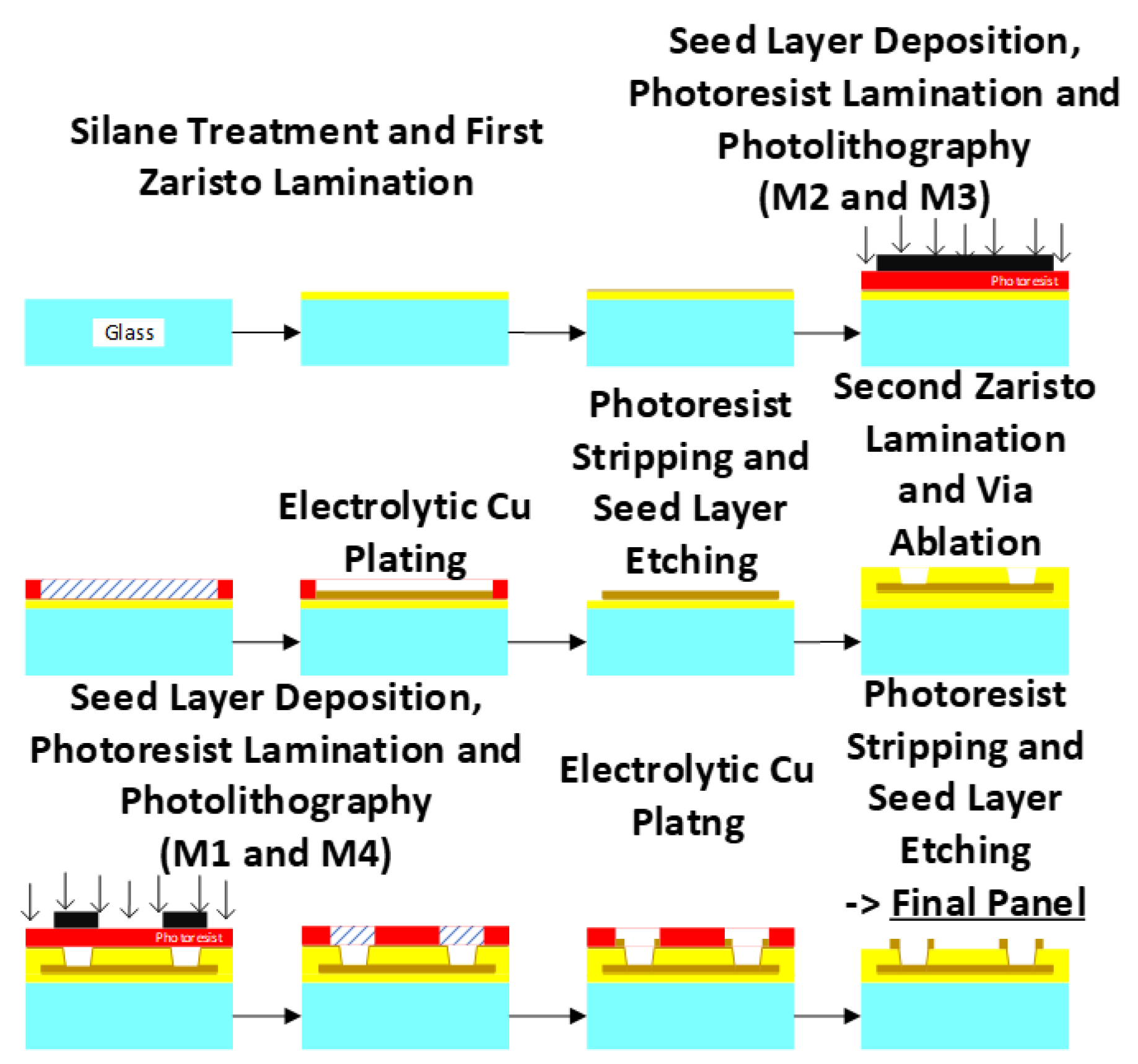
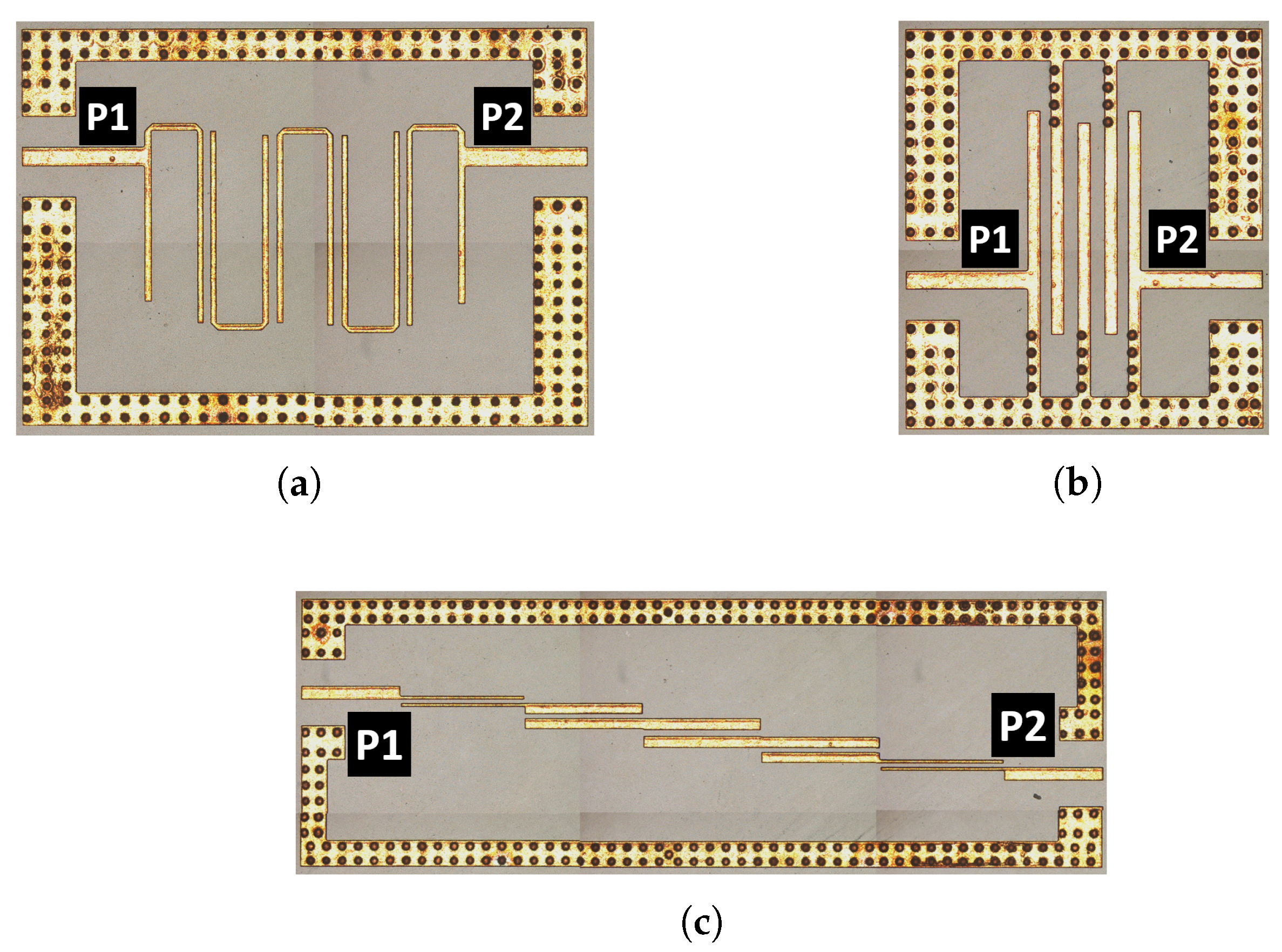



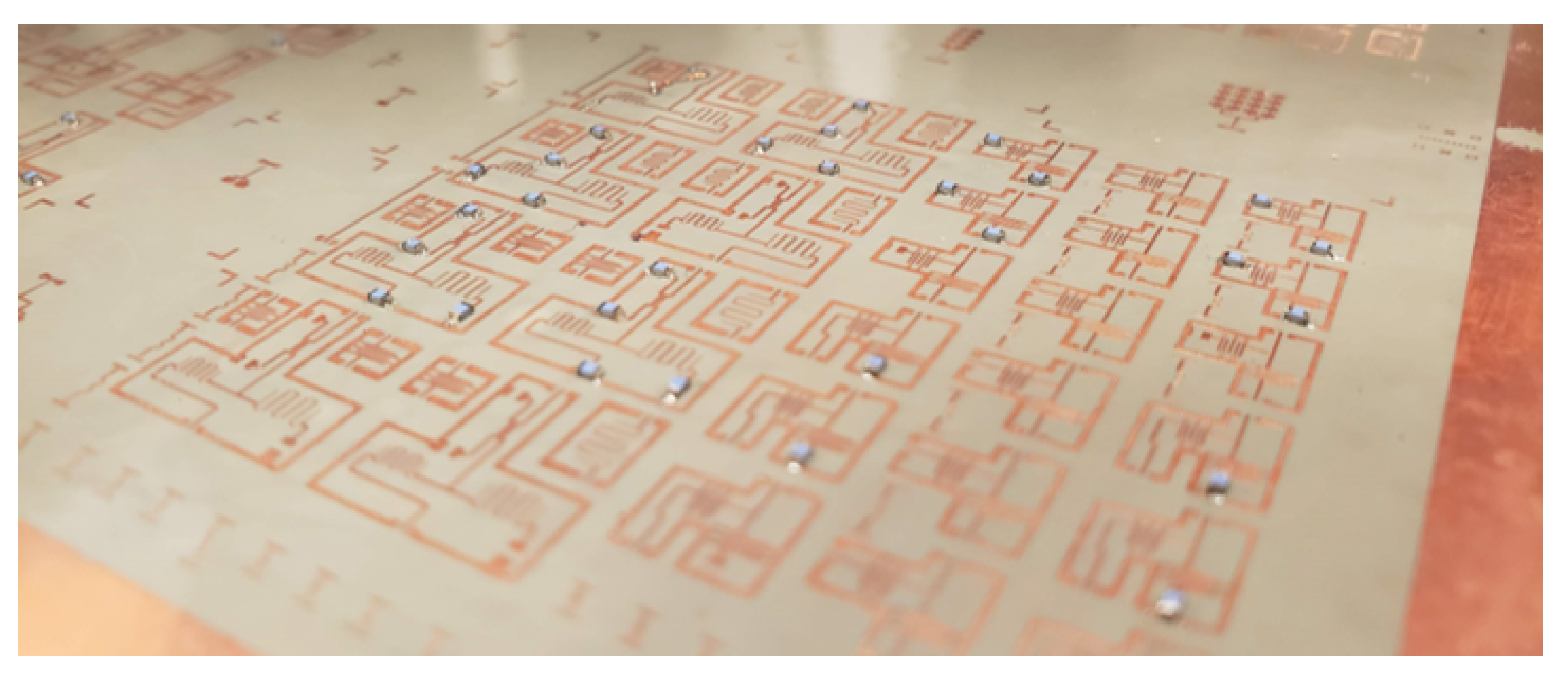


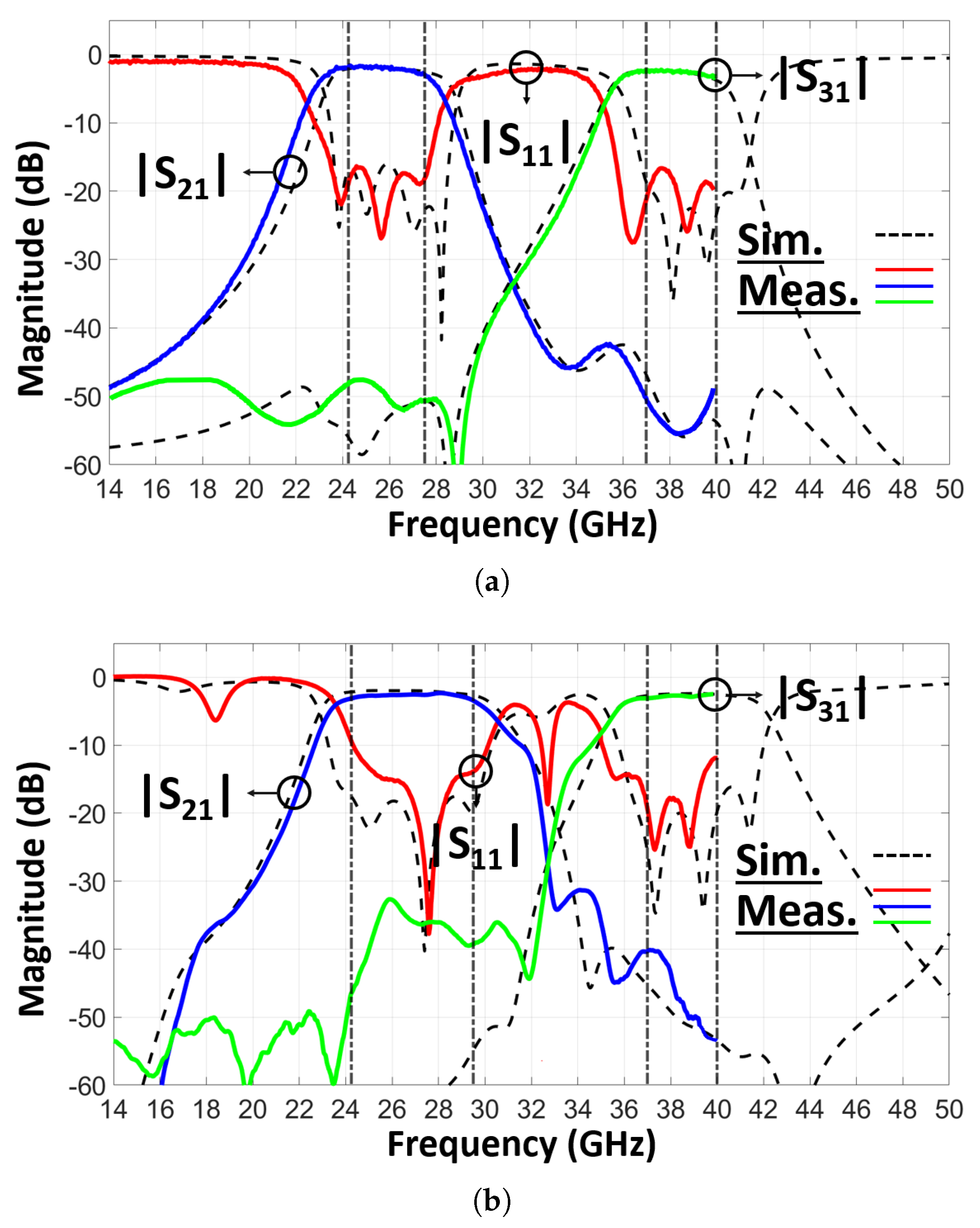
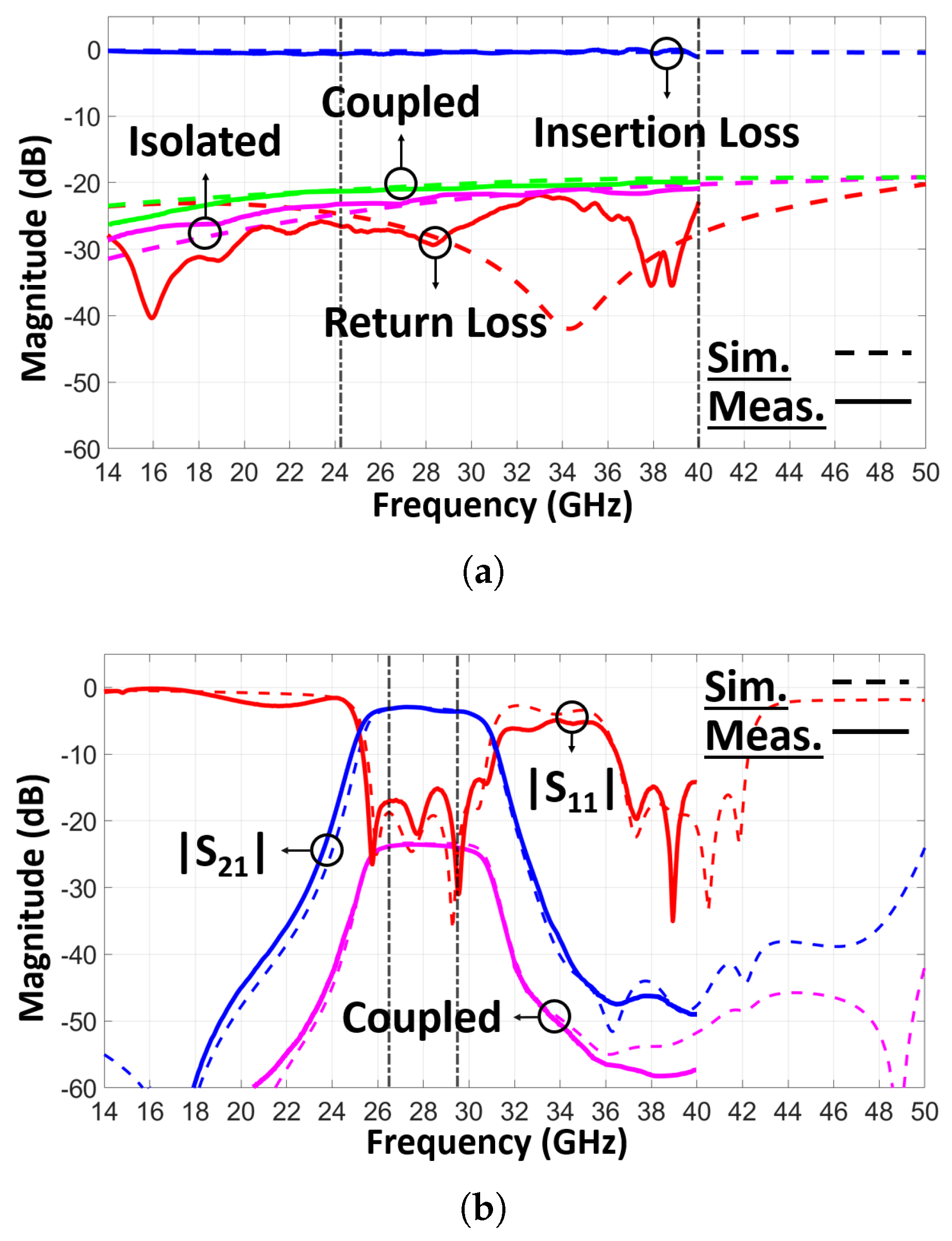
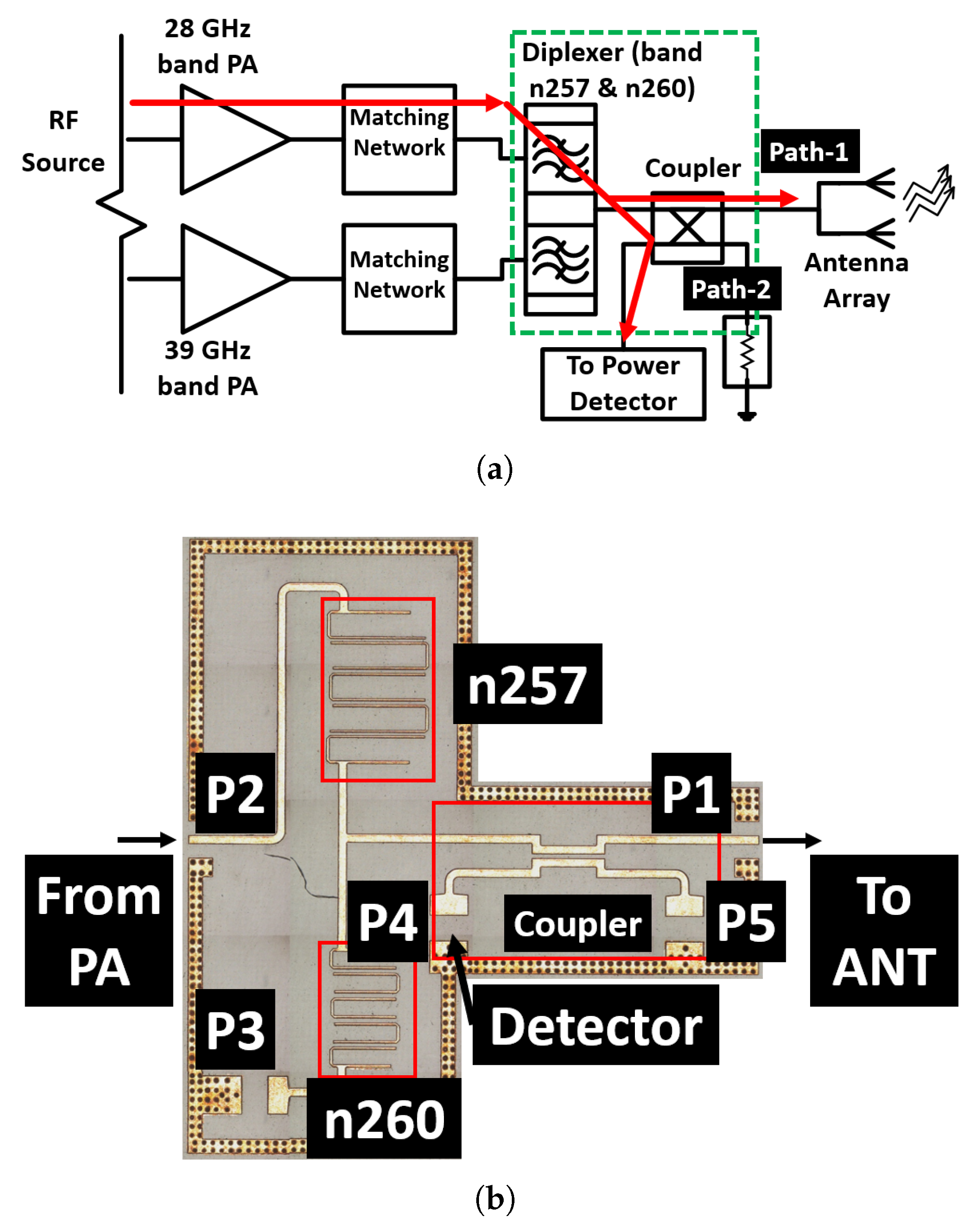



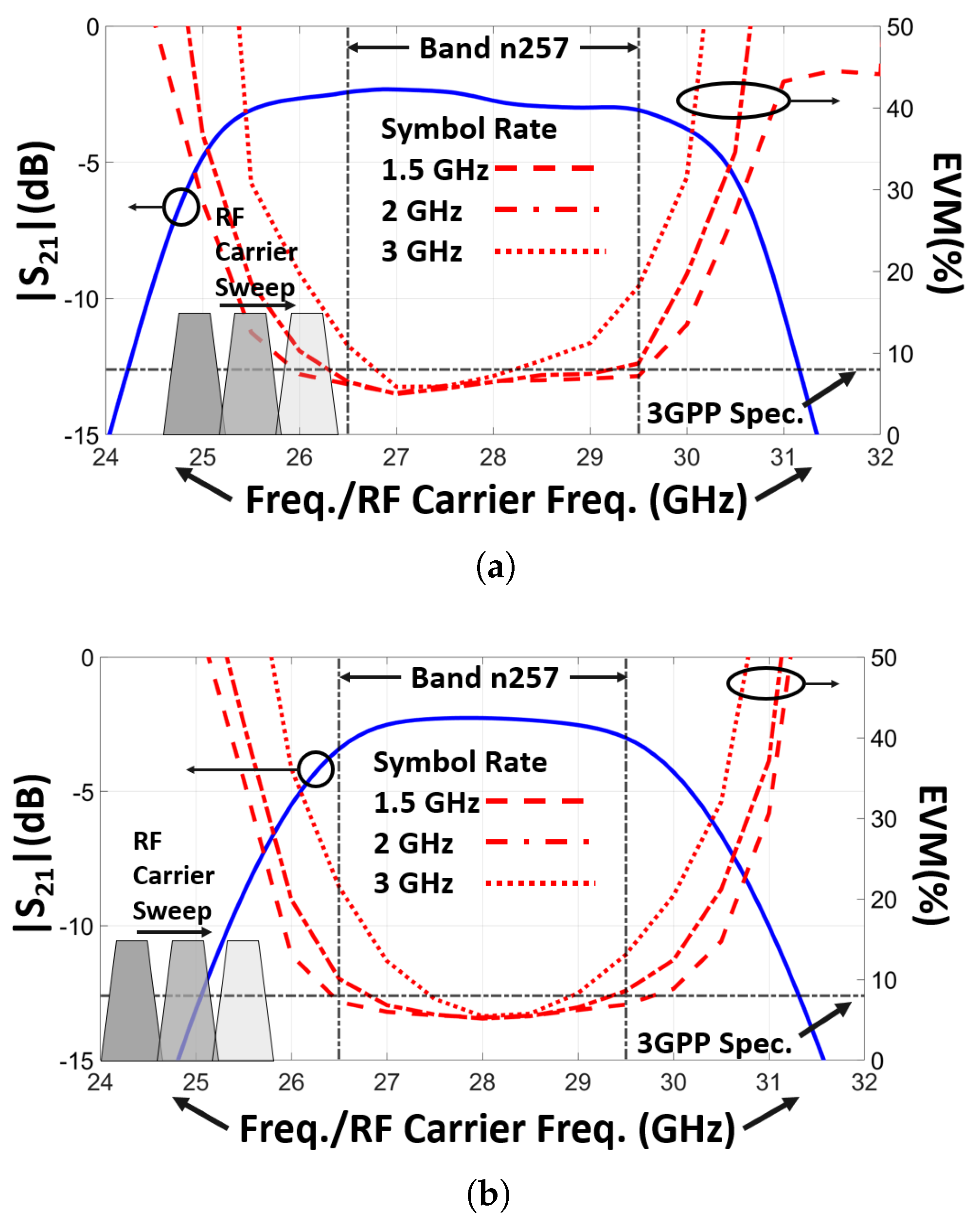
| Structure | Physical Dimensions () | Electrical Dimensions () |
|---|---|---|
| Filter—Hairpin n257 | 4.64 × 2.11 × 0.202 | 0.42 × 0.19 × 0.018 |
| Filter—Interdigital n258 | 2.94 × 2.76 × 0.202 | 0.26 × 0.25 × 0.018 |
| Filter—Edge-coupled n260 | 6.09 × 0.75 × 0.202 | 0.78 × 0.10 × 0.026 |
| Diplexer—Hairpin n257 and n260 | 5.85 × 4.42 × 0.202 | 0.63 × 0.47 × 0.022 |
| Diplexer—Hairpin n258 and n260 | 6.42 × 4.67 × 0.202 | 0.69 × 0.50 × 0.022 |
| Diplexer—Interdigital n258 and n260 | 4.4 × 4.6 × 0.202 | 0.47 × 0.49 × 0.022 |
| Diplexer—Edge–coupled n257, n258 and n260 | 11.2 × 8.49 × 0.202 | 1.2 × 0.91 × 0.022 |
| Ref. | Substrate/ Structure | Order | IL (dB) | (GHz) | BW (GHz) | Footprint () | Footprint () | Total Substrate Thickness (mm) |
|---|---|---|---|---|---|---|---|---|
| [35] | LTCC/SIW | 2 | 0.53 | 28.1 | 4.29 | 33.5 | 0.294 | 0.47 |
| [36] | LTCC/SIW | 4 | 2.66 | 27.45 | 0.98 | 43.5 | 0.364 | 0.47 |
| [37] | LTCC/SIW Cavity | 4 | 2.95 | 30 | 1.4 | 88 | 0.88 | 0.47 |
| [38] | LTCC/Stacked SIW | 4 | 2.8 | 27.95 | 1.03 | 19.7 | 0.171 | 0.4 |
| [39] | Rogers Laminate/SIW | 4 | 1.25 | 35 | 1.3 | 121 | 1.65 | 0.508 |
| [40] | Rogers Laminate/SIW | 4 | 3.6 | 29.375 | 3.75 | 81 | 0.777 | 0.3 |
| [41] | Alumina/Microstrip | 3 | 3 | 38.5 | 3 | 7.1 | 0.117 | 0.254 |
| [42] | Rogers Laminate/Air–filled SIW | 4 | 3.9 | 21 | 0.23 | 746 | 3.66 | 1.524 |
| This Work | Laminated Glass/Microstrip | 5 | 2.6 | 28 | 3 | 9.8 | 0.079 | 0.202 |
| This Work | Laminated Glass/Microstrip | 5 | 2.6 | 25.875 | 3.25 | 8.11 | 0.065 | 0.202 |
| This Work | Laminated Glass/Microstrip | 4 | 2.6 | 38.5 | 3 | 4.6 | 0.078 | 0.202 |
| Ref. | Substrate/ Structure | /BW (GHz) IL (dB) | /BW (GHz) IL (dB) | Footprint & Thickness (mm) |
|---|---|---|---|---|
| [43] | Laminate/ Microstrip | 14/- 1.9 | 28/- 4.7 | ∼80 × 0.127 |
| [44] | Laminate/ Microstrip | 32/2 3.5 | 35/1.3 3.2 | 645.16 × 0.508 |
| [45] | Laminate/ SIW | 24.925/ 1.35 2.05 | 26.8/1.8 1.95 | ∼2500 × 0.5 |
| This Work | Glass/ Microstrip | 27/3 3 | 38.5/3 3 | 25.86 × 0.202 |
| This Work | Glass/ Microstrip | 25.875/3.25 3 | 38.5/ 3 3 | 20.24 × 0.202 |
Disclaimer/Publisher’s Note: The statements, opinions and data contained in all publications are solely those of the individual author(s) and contributor(s) and not of MDPI and/or the editor(s). MDPI and/or the editor(s) disclaim responsibility for any injury to people or property resulting from any ideas, methods, instructions or products referred to in the content. |
© 2025 by the authors. Licensee MDPI, Basel, Switzerland. This article is an open access article distributed under the terms and conditions of the Creative Commons Attribution (CC BY) license (https://creativecommons.org/licenses/by/4.0/).
Share and Cite
Ali, M.; Watanabe, A.; Kakutani, T.; Raj, P.M.; Tummala, R.R.; Swaminathan, M. Package Integration and System Performance Analysis of Glass-Based Passive Components for 5G New Radio Millimeter-Wave Modules. Electronics 2025, 14, 1670. https://doi.org/10.3390/electronics14081670
Ali M, Watanabe A, Kakutani T, Raj PM, Tummala RR, Swaminathan M. Package Integration and System Performance Analysis of Glass-Based Passive Components for 5G New Radio Millimeter-Wave Modules. Electronics. 2025; 14(8):1670. https://doi.org/10.3390/electronics14081670
Chicago/Turabian StyleAli, Muhammad, Atom Watanabe, Takenori Kakutani, Pulugurtha M. Raj, Rao. R. Tummala, and Madhavan Swaminathan. 2025. "Package Integration and System Performance Analysis of Glass-Based Passive Components for 5G New Radio Millimeter-Wave Modules" Electronics 14, no. 8: 1670. https://doi.org/10.3390/electronics14081670
APA StyleAli, M., Watanabe, A., Kakutani, T., Raj, P. M., Tummala, R. R., & Swaminathan, M. (2025). Package Integration and System Performance Analysis of Glass-Based Passive Components for 5G New Radio Millimeter-Wave Modules. Electronics, 14(8), 1670. https://doi.org/10.3390/electronics14081670





